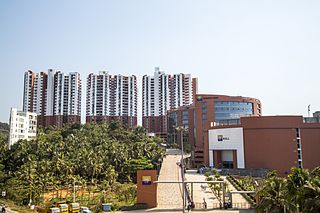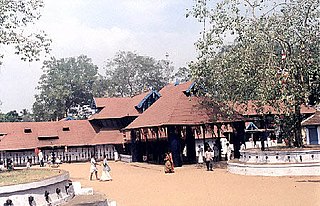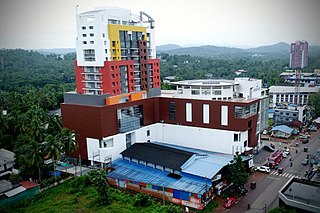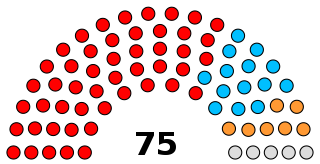Related Research Articles

Kozhikode, also known in English as Calicut, is an Indian city and the second-largest metropolitan city in the State of Kerala. It is also the 19th largest in the country with a population of two million according to the 2011 census. Kozhikode is classified as a Tier 2 city by the Government of India.

Kingdom of Cochin, named after its capital city of Kochi, was a late medieval kingdom and later princely state on the Malabar coast in South India. Once controlling much of the territory between Ponnani and Thottappally, the Cochin kingdom shrank to its minimal extent as a result of invasions by the Zamorin of Calicut. When Portuguese armadas arrived in India, the Kingdom of Cochin had lost its vassals like Edapalli, Cranganore etc to the Zamorins and was looking for an opportunity to preserve the independence of Cochin which was at risk. King Unni Goda Varma warmly welcomed Pedro Álvares Cabral on 24 December 1500 and negotiated a treaty of alliance between Portugal and the Cochin kingdom, directed against the Zamorin of Calicut. A number of forts were built in the area and controlled by the Portuguese East Indies, the most important of which was Fort Manuel, Cochin became a long-time Portuguese protectorate (1503–1663) providing assistance against native kingdoms in India. After the Luso-Dutch War, the Dutch East India Company (1663–1795) was an ally of Cochin. This was followed by the British East India Company after the Anglo-Dutch war, having suzerainty over the Cochin state. Travancore merged with the Kingdom of Cochin to form the state of Travancore-Cochin in 1950. The five Tamil-majority Taluks of Vilavancode, Kalkulam, Thovalai, Agastheeswaram, and Sengottai were transferred from Travancore-Cochin to Madras State in 1956. The Malayalam-speaking regions of the Travancore-Cochin merged with the Malabar District and the Kasaragod Taluk of South Canara district in Madras State to form the modern Malayalam-state of Kerala on 1 November 1956, according to the States Reorganisation Act, 1956 passed by the Government of India.

Māmānkam or Māmāngam was a duodecennial medieval fair held on the bank, and on the dry river-bed, of Pērār at Tirunāvāya, southern India. The temple associated with the festival was Nava Mukunda Temple in Tirunavaya. It seems to have begun as a temple festival, analogous to the Kumbha Melas at Ujjaini, Prayaga, Haridwar and Kumbakonam.

Malabar District, also known as Malayalam District, was an administrative district on the southwestern Malabar Coast of Bombay Presidency (1792-1800) and Madras Presidency (1800-1947) in British India, and independent India's Madras State (1947-1956). It was the most populous and the third-largest district in the erstwhile Madras State. The British district included the present-day districts of Kannur, Kozhikode, Wayanad, Malappuram, Palakkad, Chavakad Taluk and parts of Kodungallur Taluk of Thrissur district, and Fort Kochi area of Ernakulam district in the northern and central parts of present Kerala state, the Lakshadweep Islands, and a major portion of the Nilgiris district in Tamil Nadu. The detached settlements of Tangasseri and Anchuthengu, which were British colonies within the kingdom of Travancore in southern Kerala, also formed part of Malabar District until 1927. Malayalam was administrative as well as most spoken Lingua franca of Malabar District during British Rule. Jeseri, a distinct dialect of Malayalam, was spoken in the Laccadive Islands. Malabar District merged with the erstwhile state of Travancore-Cochin (1950-1956) to form Kerala according to the States Reorganisation Act, 1956. On the same day, the present Kasaragod district of South Canara District was also attached to Malabar, and the Laccadive&Minicoy Islands of Malabar were reorganised to form a new Union Territory. Malabar was trifurcated to form the districts of Kannur, Kozhikode, and Palakkad, on 1 January 1957.
The term Kerala was first epigraphically recorded as Ketalaputo (Cheras) in a 3rd-century BCE rock inscription by emperor Ashoka of Magadha. It was mentioned as one of four independent kingdoms in southern India during Ashoka's time, the others being the Cholas, Pandyas and Satyaputras. The Cheras transformed Kerala into an international trade centre by establishing trade relations across the Arabian Sea with all major Mediterranean and Red Sea ports as well those of the Far East. The dominion of Cheras was located in one of the key routes of the ancient Indian Ocean trade. The early Cheras collapsed after repeated attacks from the neighboring Cholas and Rashtrakutas.

Kerala is a state on the Malabar Coast of India. It was formed on 1 November 1956, following the passage of the States Reorganisation Act, by combining Malayalam-speaking regions of the erstwhile regions of Cochin, Malabar, South Canara, and Travancore. Spread over 38,863 km2 (15,005 sq mi), Kerala is the twenty-first largest Indian state by area. It is bordered by Karnataka to the north and northeast, Tamil Nadu to the east and south, and the Lakshadweep Sea to the west. With 33 million inhabitants as per the 2011 census, Kerala is the thirteenth-largest Indian state by population. It is divided into 14 districts with the capital being Thiruvananthapuram. Malayalam is the most widely spoken language and is also the official language of the state.

Islam arrived in Kerala, the Malayalam-speaking region in the south-western tip of India, through Middle Eastern merchants. The Indian coast has an ancient relation with West Asia and the Middle East, even during the pre-Islamic period.

The Ezhavas are a community with origins in the region of India presently known as Kerala, where in the 2010s they constituted about 23% of the population and were reported to be the largest Hindu community. They are also known as Ilhava, Irava, Izhava and Erava in the south of the region; as Chovas, Chokons and Chogons in Central Travancore; and as Thiyyar, Tiyyas and Theeyas in the Malabar region. Some are also known as Thandan, which has caused administrative difficulties due to the presence of a distinct caste of Thandan in the same region. The Malabar Ezhava group have claimed a higher ranking in the Hindu caste system than do the others, although from the perspective of the colonial and subsequent administrations they were treated as being of similar rank.

The Samoothiri was the hereditary monarch of the kingdom of Kozhikode (Calicut) on the South Malabar region of India. Calicut was one of the important trading ports on the south-western coast of India. At the peak of their reign, the Zamorins ruled over a region from Kollam (Quilon) to Panthalayini Kollam (Koyilandy).
The Mannanar were a Thiyyar dynasty of Malabar, in the present-day Kannur and Kasaragod districts of India. The Mannanar palace in Eruvesi to the North West of Taliparamba was called as Anju Aramana. The word Mannanar derives from mannan, meaning king and ar, which pluralises it.

North Malabar refers to the geographic area of southwest India covering the state of Kerala's present day Kasaragod, Kannur, and Wayanad districts, and the taluks of Vatakara, Koyilandy, and Thamarassery in the Kozhikode District of Kerala and the entire Mahé Sub-Division of the Union Territory of Puducherry. Traditionally North Malabar is defined as the northern portion of erstwhile Malabar District which lies between Chandragiri River and Korapuzha River. The region between Netravathi River and Chandragiri River, which included the portions between Mangalore and Kasaragod, are also often included in the term North Malabar, as the Kumbla dynasty in the southernmost region of Tulu Nadu, had a mixed lineage of Malayali Nairs and Tuluva Brahmins.

Kerala has a reputation of being, communally, one of the most religiously diverse states in India. According to 2011 Census of India figures, 54.73% of Kerala's population are Hindus, 26.56% are Muslims, 18.38% are Christians, and the remaining 0.33% follow other religions or have no religion. Various tribal people in Kerala have retained the religious beliefs of their ancestors. In comparison with the rest of India, Kerala experiences relatively little sectarianism.

Sree Kurumba Bhagavati Temple is a Hindu temple at Kodungallur, Thrissur District, Kerala state, India. It is dedicated to the goddess Bhadrakali, a form of Maha Kali or Parashakthi worshipped in Kerala. The goddess is known also by the names "Sri Kurumba"" .This temple is the head of 64 Bhadrakali temples in Kerala especially Malabar. This Maha Kali temple is one of the oldest functioning temples in India. This is attested by numerous Tamil poems and inscriptions of different times. The goddess of the temple represents the goddess in her fierce ('ugra') form, facing North, featuring eight hands with various attributes. One is holding the head of the demon king Daruka, another a sickle-shaped sword, next an anklet, another a bell, among others. Routine worship at the temple every day at 03:00 and ends at 21:00 local time.

Eranad refers to the erstwhile province in the midland area of Malabar, consisting of Malappuram and nearby regions such as Anakkayam, Manjeri, Kondotty, Nilambur, etc. Currently Eranad Taluk is a Taluk in Malappuram district. Eranad was ruled by a Samanthan Nair clan known as Eradis, similar to the Vellodis of neighbouring Valluvanad and Nedungadis of Nedunganad. The rulers of Eranad were known by the title Eralppad/Eradi. They also used the title Thirumulpad.
The legend of Cheraman Perumals is the medieval tradition associated with the Cheraman Perumals of Kerala. The sources of the legend include popular oral traditions and later literary compositions. The time of origin of the legend is not known to scholars. It seems the legend once had a common source well known to all Kerala people.
Malappuram is one of the 14 districts in the South Indian state of Kerala. The district has a unique and eventful history starting from pre-historic times. During the early medieval period, the district was the home to two of the four major kingdoms that ruled Kerala. Perumpadappu was the original hometown of the Kingdom of Cochin, which is also known as Perumbadappu Swaroopam, and Nediyiruppu was the original hometown of the Zamorin of Calicut, which is also known as Nediyiruppu Swaroopam. Besides, the original headquarters of the Palakkad Rajas were also at Athavanad in the district.

The Kozhikode Corporation, is the municipal corporation that administers the city of Kozhikode (Calicut), Kerala. Established in 1962, it is in the Kozhikode parliamentary constituency. The first mayor was H. Manjunatha Rao. Its four assembly constituencies are Kozhikode North, Kozhikode South, Beypore and Elathur. The Corporation is headed by a Mayor and council, and manages 118.58 km2 of the city of Kozhikode, with a population of about 609,224 within that area.
The Thiyyar Regiment was a military class created by British Empire that provided thousands of Thiyyar community members from Malabar for the British Indian Army. The Regiment was based in Thalassery, chosen because it was a strategic center in Malabar. There were many Thiyyar people who held the posts of subedar and jemendhar in the local militia under the East India Company, which were considered the high and responsible posts. There were lesser known Thiyya regiments and Thiyyar Pattalam formed by the French and British governments in Mahe and Thalassery. The British deployed the unit in various military operations.
Cherayi Panikkar is the title of a Thiyyar caste, especially in some parts of the Malappuram district of Malabar. The Thiyyar chiefs in North Malabar bears the title of cherayi panikar, a title given only to one specially proficient in arm.
References
- ↑ Singh, Kumar Suresh (1998). India's Communities: H - M. Oxford University Press. ISBN 978-0-19-563354-2.
- ↑ Greece), Peter (Prince of (1963). A Study of Polyandry. Mouton.
- ↑ Thurston, Edgar; Rangachari, K. (1909). Castes and tribes of southern India. University of California Libraries. Madras : Government Press. p. 12.
- ↑ Kerala (India) (1962). Kerala District Gazetteers: Mapappuram. Superintendent of Government Presses. p. 66.
- ↑ Journal of Kerala Studies. University of Kerala. 2009. p. 203, 205.
- ↑ Journal of Kerala Studies. University of Kerala. 2009. p. 205.
- ↑ "Standing Committee on Social Justice and Empowerment (2006-2007)" (PDF). p. 13.